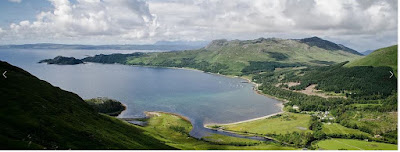It's always great to get a
glowing review. But nothing beats the kind of email I've just received from Carol
Annett, who was born a MacKinnon.
Those who have
read Flight of the Highlanders will recall that Chapter One treats the violent eviction of a great number of
McKinnons from Knoydart in 1853. It
"Thank
you for writing Flight of the Highlanders. You have done an amazing
job of telling this story. I can appreciate what an enormous amount of research
was involved. What a feat to pull the disparate threads together.
"This subject has
been my passion for the past ten years as I have been researching and writing
the story of my ancestors. I am a direct descendant of Highlanders from
Knoydart who sailed to Canada in 1853 aboard the Sillery. It
was exciting to read the familiar, though horrific account of events at
Knoydart in your first chapter.
"In 2016, I had the
amazing good fortune to live for a week with a couple whose house is at
Samadalan, Knoydart, the exact location of the village where my McKinnon
ancestors lived. My friend had a keen interest in the history of her home and
property, which was essentially an archeological site.
"On census records my
friend had for the post-clearance years, I noticed that Allan McKinnon was
still living at Samadalan. That led me to research every single family
mentioned by Donald Ross in his account. What I found surprised me.
"My research shows
that Allan McKinnon and John McKinnon, both mentioned by Ross, were the
brothers of my great-great-great-grandfather, Archibald McKinnon, who left on
the Sillery. The records show that 11 of the 16 families interviewed
by Donald Ross remained on Knoydart for the rest of their lives, despite repeated
efforts to evict them. I have census and death records for each of them. The
last person died in 1909 at the age of 82. Many, but not all of them, died in
poverty.”
Ms. Annett attached a
PDF of an article she published in a genealogical quarterly called Anglo-Celtic Roots. It
begins as follows:
Imagine you are Archibald McKinnon and the year is 1853. Your
homeland, Knoydart, lies within a rugged region of the Scottish Highlands
called the “Rough Bounds” or “Na Garbh-Criochan,” as you say in Gaelic. The
place-name, Knoydart, is not of Gaelic origin. It means “Knut’s Fjord,” named
by the Norse who once occupied the west coast of Scotland.
Though
centuries have passed since the Vikings departed, this stark wilderness has not
changed. Across the water from your house you see the mountains of Skye— the
jagged Cuillin and the cone-shaped Red Hills—depending on the weather. It rains
often and storms can be severe. On fair evenings, you are dazzled by a
brilliant sunset or awed by the occasional sight of the shimmering aurora borealis.
You live in this austerely
sublime
landscape with an abundance of wildlife—seals, dolphins, whales, eagles,
gannets, otter and deer—and about 1,000 people.
In
August of this year, one-third of these people—including you—will leave
Knoydart, and Scotland, forever. . . .
You can read the rest here:
https://bifhsgo.ca/upload/
You can read the rest here:
https://bifhsgo.ca/upload/
Me again: you can see why I love this, right?








No comments:
Post a Comment